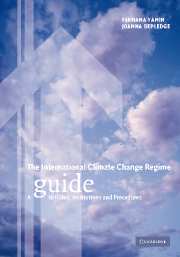Book contents
- Frontmatter
- Contents
- List of figures
- List of tables
- List of boxes
- Foreword by Joke Waller Hunter, Executive Secretary, FCCC
- Preface and acknowledgements
- List of abbreviations
- 1 Introduction
- 2 Overview
- 3 Regime participants
- 4 Objective and principles
- 5 Mitigation commitments
- 6 Flexibility mechanisms
- 7 Research, systematic observation, education, training and public awareness
- 8 Adaptation
- 9 Impacts of response measures
- 10 Finance, technology and capacity-building
- 11 Reporting and review
- 12 Compliance
- 13 Institutions
- 14 The negotiation process
- 15 Scientific and technical input
- 16 Administering the regime
- 17 Linkages
- 18 Evolution of the regime
- 19 Conclusion: taking stock and moving forward
- Appendix I List of Parties, their groups and key statistics
- Appendix II Annex I Party fact sheets: emissions, targets and projections for Annex I Parties and groupings
- Appendix III Table of Articles, issues and COP Decisions
- Bibliography
- Index
16 - Administering the regime
Published online by Cambridge University Press: 16 July 2009
- Frontmatter
- Contents
- List of figures
- List of tables
- List of boxes
- Foreword by Joke Waller Hunter, Executive Secretary, FCCC
- Preface and acknowledgements
- List of abbreviations
- 1 Introduction
- 2 Overview
- 3 Regime participants
- 4 Objective and principles
- 5 Mitigation commitments
- 6 Flexibility mechanisms
- 7 Research, systematic observation, education, training and public awareness
- 8 Adaptation
- 9 Impacts of response measures
- 10 Finance, technology and capacity-building
- 11 Reporting and review
- 12 Compliance
- 13 Institutions
- 14 The negotiation process
- 15 Scientific and technical input
- 16 Administering the regime
- 17 Linkages
- 18 Evolution of the regime
- 19 Conclusion: taking stock and moving forward
- Appendix I List of Parties, their groups and key statistics
- Appendix II Annex I Party fact sheets: emissions, targets and projections for Annex I Parties and groupings
- Appendix III Table of Articles, issues and COP Decisions
- Bibliography
- Index
Summary
Introduction
The administrative basis of the climate change regime was established in February 1991, when the UN Secretary-General called upon an UNCTAD official to head a team of a dozen seconded staff, working in borrowed offices and on a shoestring budget, to manage the negotiation of what became the FCCC. The administration of the climate change regime has since evolved into a complex enterprise, involving a Secretariat of over 160 staff members and a total annual budget, including several trust funds, of more than US $20 million. This chapter explores how the climate change regime is administered, focusing on its finances and the role of the Secretariat.
The programme budget
Financial procedures
In its Article 7.2 (k), the Convention calls upon the COP to ‘agree upon and adopt … financial rules for itself and for any subsidiary bodies’. This was done at COP-1, with Decision 15/CP.1 establishing the financial basis for the operation of the COP, the SBs and the Secretariat. These financial procedures are founded on the wider Financial Regulations and Rules of the United Nations, which apply where Decision 15/CP.1 is silent.
According to the financial procedures, the Executive Secretary prepares a draft programme budget every two years for the next biennium. This draft, which is circulated to Parties at least ninety days before the opening of the COP where it is due for adoption, is negotiated in the SBI and adopted by the COP by consensus.
- Type
- Chapter
- Information
- The International Climate Change RegimeA Guide to Rules, Institutions and Procedures, pp. 487 - 508Publisher: Cambridge University PressPrint publication year: 2004



